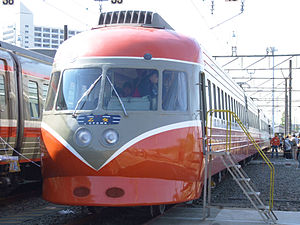Odakyū series 3000 SE
| Odakyū series 3000 SE | |
|---|---|
| Year of construction (s): | 1957 |
| Retirement: | 1991 |
| Gauge : | 1067 mm ( cape track ) |
| Length: | 15,950 mm (control car of the original series and the 1962 series) 16,150 mm (control car of the 1968 series) 12,700 mm ( intermediate car) |
| Height: | 3,450 mm (control car and normal middle car) 4,015 mm (panorama middle car) |
| Width: | 2,864 mm |
| Empty mass: | 146.75 t (original series) 159 t (1962 series) 113.47 t (1968 series) |
| Top speed: | 145 km / h (world record run) 110 km / h (regular operation) |
| Continuous output : | 100 kW |
| Acceleration: | 1.6 km / h / s |
| Power system : | 1500 V |
| Power transmission: | Overhead line |
| Brake: |
Engine brakes , disc brakes |
| Train control : | OM-ATS, ATS-S |
| Seats: | 348 (original series) 316 (1962 series) 222 (1968 series) |
| Classes : | normal (2nd class), green class (1st class) |
The Odakyū series 3000 ( Japanese 小田急3000形電車 , Odakyū 3000 gata densha was) a Romancecar -Schnellzug private Japanese railway company Odakyu Electric Railway , which was 1957-1991 in use. It was used for tourism in the Tokyo area, where it ran from central Tokyo via the Odawara line to tourist destinations in the hinterland.
history
With increasing prosperity in Japanese society in the wake of economic growth in the post-war period, the need for domestic tourism increased. Odakyū Dentetsu therefore decided to develop an electric multiple unit, which should be specially designed for use in tourist traffic. The development took place in cooperation with the state Railway Technical Research Institute (RTRI). For the state-owned Japanese railway company JNR and its research institute RTRI, this cooperation made perfect sense, because at that time there was still intense discussion within the JNR about whether the future of the planned Japanese high-speed Shinkansen network should be operated with multiple units or with locomotive-hauled trains. Since Odakyū Dentetsu had opted for a multiple unit, JNR and RTRI were able to share in the findings.
During a test run on the Tōkaidō main line in 1957, the Odakyū series 3000 was able to achieve a new world record for trains of the Cape Gauge with 145 km / h . This new world record was the main trigger for the development of the high-speed multiple units of the Shinkansen series 0 .
commitment
The vehicles of the Odakyū series 3000 SE were used as the first romance car trains between Tokyo and Hakone as an 8-car unit from 1957 . The "SE" stood for "Super Express".
From 1968, the trains were rearranged and several new control cars were procured so that they could be operated as 5-car units from now on. This changed the addition from "SE" to "SSE", which stood for "Short Super Express". The vehicles remained in service in this formation until 1991.
technology
The Odakyū series 3000 was a continuous articulated multiple unit in lightweight construction. It had a very low center of gravity and the exterior was particularly aerodynamic. Both should contribute to the highest possible average speed. Due to the very winding route, the trains could never reach the technological top speed in regular operation.
Overall, the latest technological findings were used in their construction.
Web links
Individual evidence
- ↑ Kenji Inayama (2001): JNR's Choice of Traction System - From Loco-hauled to Multiple-unit Trains (English; PDF file; 1.05 MB)
